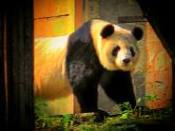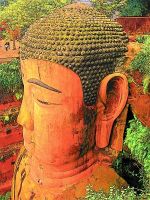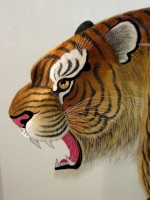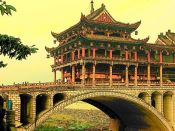They look soft, fuzzy and cuddly, and ready for fun, despite their black-and-white tuxedos and prepared-for-a-grand-ballroom-entrance look. Underneath the drab formalwear, one suspects colorful personalities.

The giant panda bear is the No. 1 tourist attraction in Sichuan Province of China. Some 1,600 pandas live in the wild, 80 percent of them in Sichuan.
Ah, but looks can be deceiving.
Soft, fuzzy and cuddly? Not exactly. Petting one feels like petting a giant-sized Brillo Pad.
Colorful? Sure, in their own special way.
“It’s an amazing creature,” Adam Meredith of England said. “It doesn’t seem to do much apart from eat and sleep, but the way it does it is so fascinating, you can’t help but fall in love with the animal.
“I mean, look at their eyes. You can’t resist them. They could steal my belongings and I wouldn’t mind.”
With a pair of black-eye patches, they look the part of bandits, yet all they do is steal your heart.
Giant panda bears have that effect on people.
The panda is the modern iconic symbol of China behind the traditional symbol of the dragon. Pandas are lovable creatures embraced not only by the Chinese but by the world.
Which is why the giant panda is the No. 1 tourist attraction in the Sichuan Province of China, home to 80 percent of the last remaining wild pandas, of which there are an estimated 1,600.
Some 90 panda bears reside at the Bifengxia Panda Base and Giant Panda Bears Research Center in Ya’an, about a 1 1/2-hour drive from Chengdu, the capital of Sichuan Province.
In the surrounding vicinity, about 200 pandas reside, though spotting a wild panda is only slightly more likely than finding that needle in the haystack.
Not so at the Bifengxia Panda Base.
Take a walk or shuttle ride to various areas of the base and one can spot pandas lazily perched on tree limbs within a contained yard, baby pandas in incubators in the research center or a panda sitting on a bench next to a tourist.
Yes, it’s true. Unique to Bifengxia, tourists can share a bench with a panda.
To pet a panda or hold a baby panda, one must provide a medical clearance from a doctor to prove one is healthy and not carrying a disease the panda could catch.
The animal is endangered, after all.
Once cleared, tourists must don a doctor’s smock and gloves. Only then are they allowed to pet the panda, or if the timing is right and babies are available, to hold a baby panda.
Get a photo quickly because your time is limited.
“Nowhere else can you find a place like this,” said Yan Liao, president of First Sino-US. “This is really the highlight of our trip because only in Sichuan can you see so many pandas and be able to interact with the panda. At other zoos — no way, you can’t do that.”
The panda’s gentleness allows Bifengxia Panda Base the opportunity to offer close encounters by tourists. Distract a panda with a carrot and it’ll happily munch away while getting its picture taken sitting next to a tourist.
Carrots are a treat. In the wild, bamboo is the panda’s food source, said to be in short supply. Farmers in or near the national reserve of pandas are encouraged to grow bamboo for this reason, according to Li Wei of the China Conservation and Research Center for the Giant Panda at Bifengxia.
However, the primary reasons for the low panda population are threefold, Li said through an interpreter.
“It’s difficult for them to find a mate and if they do mate, it’s very difficult for them to get pregnant,” he said. “Once they produce a baby, it’s very difficult for the baby to survive because naturally pandas are not very good parents.”
With technology, survival rates improved dramatically in 1997 with research funded by the Chinese government, the community and the World Wildlife Fund, whose symbol is the panda. Survival rates were under 40 percent in the early days of research. Now it’s said to be more than 90 percent.
“We’re generally happy with what they’ve done, but more can be done, like DNA of the panda family, the relationship with habitat,” Li said. “There’s huge research work ahead…They (the research center) need more people to get involved.
“The ultimate goal is not to keep panda in captivity here, because the panda is a wild animal and it’s an endangered species, and it’s very difficult to breed in the natural habitat. So after the research, the ultimate goal is to help the panda survive in the wild.”
—————————————————-
- SIDE NOTES: China’s first national panda research center at Wolong was built in 1963. On May 12, 2008, an earthquake registering 8.5 on the Richter Scale hit 50 miles west-northwest of Chengdu. The Wolong Research Center was destroyed. Of the 63 captive pandas, one was seriously injured, one suffered light injuries, one was missing and one died. Most of the remaining pandas were relocated to Bifengxia where they’ll stay as Wolong is rebuilt.
- It takes more than $2 million yearly to feed and care for the pandas at the research center, which has 150 fulltime staff. Volunteers from all over the world offer assistance. At any given time, there could be up to 100 volunteers on site.
- Nearly a million people visit the research center each year. Most foreigners are from Korea and Japan. Only about 3,000 Westerners visit this most unique place annually.
—————————————————-
- See the video
- See more photos
- Next week: Mount Emei.
- Still to come: The Human Taxi, wild monkeys and 5000-year-old artifacts.




 Posted by David Strege
Posted by David Strege 










